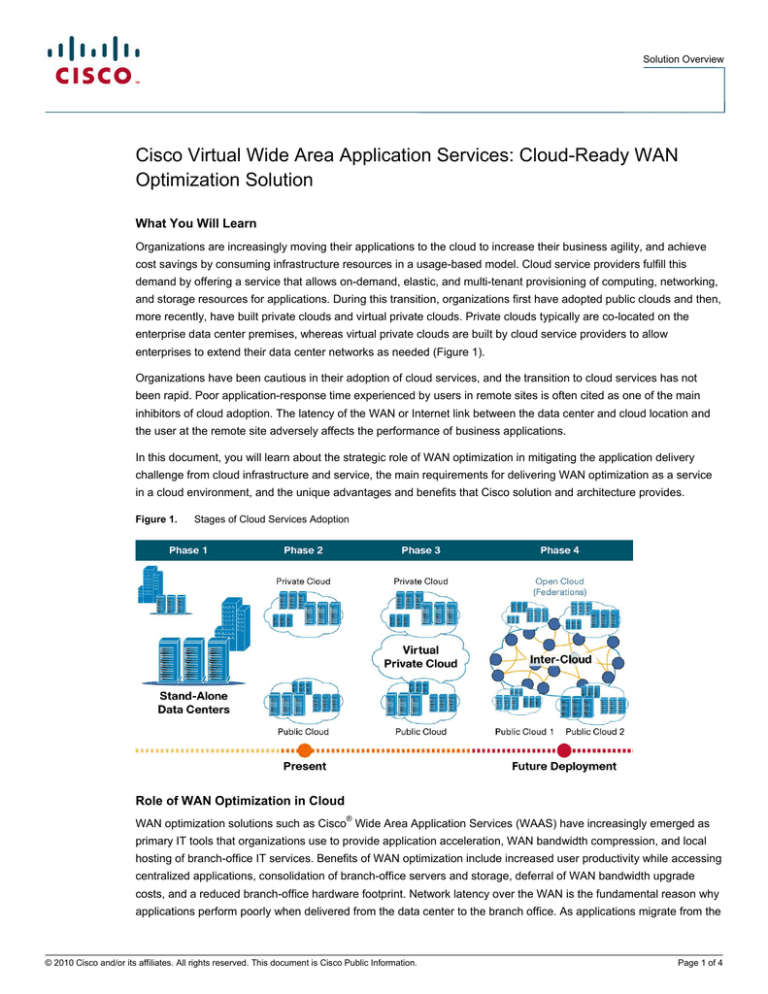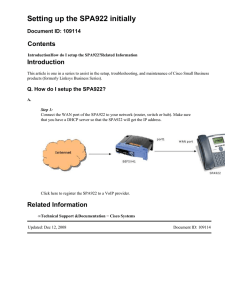
Solution Overview
Cisco Virtual Wide Area Application Services: Cloud-Ready WAN
Optimization Solution
What You Will Learn
Organizations are increasingly moving their applications to the cloud to increase their business agility, and achieve
cost savings by consuming infrastructure resources in a usage-based model. Cloud service providers fulfill this
demand by offering a service that allows on-demand, elastic, and multi-tenant provisioning of computing, networking,
and storage resources for applications. During this transition, organizations first have adopted public clouds and then,
more recently, have built private clouds and virtual private clouds. Private clouds typically are co-located on the
enterprise data center premises, whereas virtual private clouds are built by cloud service providers to allow
enterprises to extend their data center networks as needed (Figure 1).
Organizations have been cautious in their adoption of cloud services, and the transition to cloud services has not
been rapid. Poor application-response time experienced by users in remote sites is often cited as one of the main
inhibitors of cloud adoption. The latency of the WAN or Internet link between the data center and cloud location and
the user at the remote site adversely affects the performance of business applications.
In this document, you will learn about the strategic role of WAN optimization in mitigating the application delivery
challenge from cloud infrastructure and service, the main requirements for delivering WAN optimization as a service
in a cloud environment, and the unique advantages and benefits that Cisco solution and architecture provides.
Figure 1.
Stages of Cloud Services Adoption
Role of WAN Optimization in Cloud
WAN optimization solutions such as Cisco® Wide Area Application Services (WAAS) have increasingly emerged as
primary IT tools that organizations use to provide application acceleration, WAN bandwidth compression, and local
hosting of branch-office IT services. Benefits of WAN optimization include increased user productivity while accessing
centralized applications, consolidation of branch-office servers and storage, deferral of WAN bandwidth upgrade
costs, and a reduced branch-office hardware footprint. Network latency over the WAN is the fundamental reason why
applications perform poorly when delivered from the data center to the branch office. As applications migrate from the
© 2010 Cisco and/or its affiliates. All rights reserved. This document is Cisco Public Information.
Page 1 of 4
Solution Overview
data center to the cloud to generate cost savings, organizations are asking the question: “Is WAN optimization
required?”
Applications hosted on public cloud infrastructure typically are delivered from the Internet. The Internet is a shared
infrastructure with no guarantee of bandwidth or network performance, unlike a corporate WAN, for which
administrators can design predictable paths to limit packet latency and loss. Industry surveys show that
approximately 60 to 70 percent of customers backhaul Internet traffic from their branch locations through their data
centers. As applications move to the cloud, the number of WAN and Internet hops experienced by these remote
branch offices will likely increase. Thus, WAN optimization technology becomes more important strategically than
ever to overcome the negative effects of WAN latency and to help enable cloud adoption. Consequently, WAN
optimization needs to be an integral component of cloud-based application delivery architectures. Today, Cisco
WAAS appliances, router-integrated Cisco WAAS modules, and Cisco WAAS Mobile accelerate software-as-aservice (SAAS) applications over the corporate WAN when delivered from the public cloud to the branch office.
Private and virtual private cloud architectures offer an opportunity to build WAN optimization as a service in response
to the current provisioning and decommissioning of application server virtual machines on a utility basis. Such a
capability allows private and virtual private cloud service providers to offer value-added cloud-optimized application
services on demand in their catalogs of cloud services, helping increase revenue and differentiation among providers.
Current Infrastructure-as-a-service (IaaS) offerings such as basic computing, networking, and storage are expected
to become increasingly commoditized.
Main Requirements for a WAN Optimization Service in the Cloud
To offer WAN optimization as a service in a cloud environment, several requirements must be met:
●
On-demand deployment model: Associate the WAN optimization service with specific application server virtual
machines, giving the cloud provider the agility and capability to offer a differentiated optimized-application
service in contrast to basic computing service.
●
Minimal network configuration with increasing scale: As new server virtual machines are instantiated to
accommodate increasing application load, the network configuration needed to optimize these new virtual
machine instances should be minimal; ideally, no work should be required at all.
●
Virtual machine-mobility awareness: Given the dynamic nature of cloud resource pools, the WAN optimization
service provided to a set of application servers needs to be continually available regardless of the physical
location of the application server virtual machines.
●
Support for multi-tenant deployments: A multi-tenant deployment model must be supported, to reduce the
amount of hardware required and to lower the fixed hardware costs for the cloud service provider.
●
Elastic scale-out deployment: The WAN optimization service will need to scale in different ways
simultaneously for different tenants as demand grows or diminishes. This process requires an elastic scaleout deployment architecture.
Any solution that attempts to meet these requirements should be virtualized. Virtual appliances can be deployed on
demand, unlike hardware appliances, which need to be racked, stacked, and cabled. Virtualization reduces hardware
costs in environments serving multiple organizations because a dedicated device is not needed for each tenant. As
user demand increases, IT managers can easily scale up performance of virtual appliances by moving them to a
more powerful platform or by allocating more resources on existing platforms and using the scalable nature of virtual
computing environments. However, virtual form-factor alone is not sufficient to meet all requirements.
Cisco Virtual WAAS: The First Cloud-Ready WAN Optimization Solution
Cisco Virtual WAAS (vWAAS) is the industry’s first cloud-ready WAN optimization solution. Cisco vWAAS is a virtual
appliance that accelerates business applications delivered from private and virtual private cloud infrastructures,
© 2010 Cisco and/or its affiliates. All rights reserved. This document is Cisco Public Information.
Page 2 of 4
Solution Overview
helping ensure an optimal user experience. Cisco vWAAS runs on the VMware ESXi hypervisor and Cisco Unified
Computing System™ (UCS) x86 servers, providing an agile, elastic, and multi-tenant deployment (Figure 2).
Figure 2.
Cisco vWAAS Deployment Architecture
Cisco vWAAS can be deployed in two ways:
●
Transparently at the WAN network edge using out-of-path interception technology such as Web Cache
Control Protocol (WCCP), similar to deployment of a physical Cisco WAAS Appliance
●
Within the data center along with application servers, using a virtual network services framework based on
Cisco Nexus® 1000V Series Switches to offer cloud-optimized application service in response to instantiation
of application server virtual machines
Cisco vWAAS is the only WAN optimization service that supports on-demand orchestration, using policy-based
operations, on a per-application basis. Using policy-based configuration in the Cisco Nexus 1000V, Cisco vWAAS
service is associated with application server virtual machines even as they are instantiated or moved, as shown in
Figure 3. This approach enables cloud providers to offer rapid delivery of WAN optimization service with minimal
network configuration or disruption in cloud-based environments. Service providers can use Cisco vWAAS to offer a
cloud-optimized application service over the WAN as a value-added and differentiated service in their catalogs of
cloud services.
Figure 3.
On-Demand Orchestration of Cisco vWAAS with Minimal Network Configuration Using Cisco Nexus 1000V Integration
© 2010 Cisco and/or its affiliates. All rights reserved. This document is Cisco Public Information.
Page 3 of 4
Solution Overview
Cisco vWAAS is fully interoperable with physical Cisco WAAS Appliances and router-integrated form factors to
provide investment protection for existing Cisco WAAS deployments. The Cisco vWAAS Central Manager (vCM) is a
virtual appliance that provides common management of physical and virtual Cisco WAAS instances.
In addition, Cisco vWAAS will support features such as separation of computing and storage resources with its data
redundancy elimination (DRE) cache stored over the SAN. This feature provides benefits such as more rapid
recovery from failure without loss of cache history in comparison to physical appliances.
Conclusion
Cloud-based application delivery to the branch office has been inhibited by poor performance. WAN optimization is a
strategic technology that addresses this problem. Cloud service providers can differentiate their services by including
a cloud-ready WAN optimization service and mitigate the eventual commoditization of computing, networking, and
storage as a service that they offer today.
Requirements for a cloud-ready WAN optimization solution include on-demand orchestration in response to the
creation or movement of application server virtual machines, minimal network configuration in a dynamic
environment, elastic scale-out, and multi-tenancy support. A virtual form-factor for WAN optimization is necessary but
not sufficient.
Cisco vWAAS is the industry’s first cloud-ready WAN optimization solution to meet these requirements, using policybased operations based on Cisco Nexus 1000V Series architecture. Cisco vWAAS is fully interoperable with existing
Cisco WAAS appliances and router-integrated modules, which can all be managed by a common central manager,
available in virtual form as well. Cisco vWAAS offers advanced features such as SAN storage for its DRE cache,
allowing faster recovery after failure through separation of computing and storage resources. Cisco vWAAS provides
a path for private and virtual private cloud architects to deliver an excellent application experience over the WAN as a
value-added service in their catalogs of cloud services.
For More Information
●
Cisco WAAS: http://www.cisco.com/go/waas
●
Cisco Unified Network Services: http://www.cisco.com/go/uns
Printed in USA
© 2010 Cisco and/or its affiliates. All rights reserved. This document is Cisco Public Information.
C22-620028-00
09/10
Page 4 of 4


